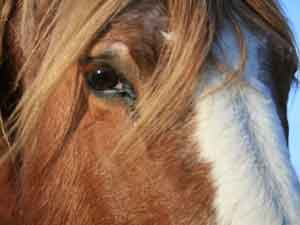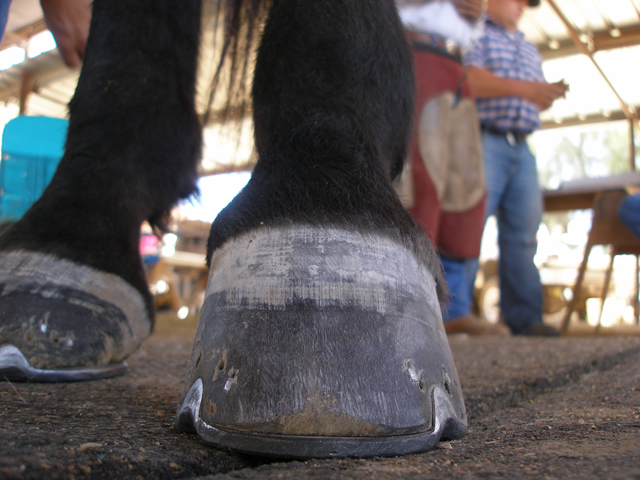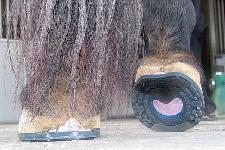|
|
Contact Information: |
If your horse's hooves break, split or grow unevenly, they can cause your horse to become lame. When people wear shoes that don't fit properly, their balance and spinal health are compromised: proper hoof care for horses is as important as wearing properly fitting shoes is for humans.
Aside from environmental factors, breeding affects the way your horse's hooves work. Whereas wild horses with poor hooves would have been taken out by natural selection, bred horses can pass along the genetics that create weak or badly shaped hooves.
 Working horses need to be shod to protect their hooves;
hooves need trimming about every six weeks, finding a good farrier is
vital to keeping your horse in good shape. You'll want to consult with an
expert about when your horse should start wearing shoes and the type of shoes
that will work best for the kind of activities your horse will take part in. Talk
to your farrier about the way you plan to work with your horse, so your horse gets
the right shoes and the right fit.
Working horses need to be shod to protect their hooves;
hooves need trimming about every six weeks, finding a good farrier is
vital to keeping your horse in good shape. You'll want to consult with an
expert about when your horse should start wearing shoes and the type of shoes
that will work best for the kind of activities your horse will take part in. Talk
to your farrier about the way you plan to work with your horse, so your horse gets
the right shoes and the right fit.
The farrier removes the shoes, trims the hooves and replaces the shoes. Shoes won't keep your horse's hooves from growing; if they aren't trimmed often enough, or if they shoes stay on too long, your horse will go lame.
Shod hooves do pick up more debris than unshod ones, and the
packed rocks, mud or even ice can cause your horse pain and injury. Pick out
your horse's feet each day to remove foreign matter and prevent infection.
A good farrier is worth his weight in gold. Remember, "no hoof, no horse!"
-equine affair mag
Should my horse go barefoot?
If your horse has tough, smooth hooves that aren't inclined to get too long in the toe, or deform in other ways, and if your activities don't require special shoes for support, you horse may be able to get along just fine barefoot. The hooves will still need professional trimming every six to eight weeks; many horse owners eventually learn to do this work for themselves.
A
drawback to wearing shoes include more difficulty in keeping the hooves clean, the fact that shoes sometimes catch on steps, or rails, can cause serious injury. Not to mention that getting kicked with a hoof, is a wee bit less dangerous than being kicked by a hoof with a steel shoe. Much depends on the conformation of your horse's feet and legs, as well as the way you intend to work your horse. So, talk to your vet and speak with a farrier before deciding if your horse can go without shoes.|
Remember: We have removed the horse from his own wild environment. For many thousands of years, his hooves took care of themselves without our help. Now, it's up to each horse owner to take full responsibility and provide good hoof care! |
Did Someone Say . . . Glue?
The next time your horse needs shoes, don’t be surprised if the farrier brings out the 'glue' rather than the nails. These nail-less alternatives will not replace normal horseshoeing, but when your horse has a hoof problem; glue can be a temporary and helpful solution.
During the mid-80's
, a flexible acrylic adhesive called "Equilox" was designed and developed to help repair hoof-wall losses and cracks. To use it, your farrier will trim and prepare the hoof as usual and use a shoe with quarter clips. The shoes will be sized to extend slightly past the hoof wall from the widest part of the hoof toward the heel. Both the hoof and the shoe are washed with a chemical solvent to ensure the horse's natural body oils and any foreign materials are removed just prior to the application. The glue is then prepared by combining the two chemicals and adding fine fiberglass strands. This combination makes Equilox more flexible and can be easily molded. By adding the fiberglass strands to the compound provides more structural strength to the bond. The mixture is then placed specifically around the prepared hoof, starting at the quarter and extending down to the heel.
 The aluminum shoe is then set in place and the excess composite on
the surface of the hoof is molded into the sole’s existing concavity. By
forming an additional sole in this way, extra protection is provided to the horse’s
hoof. The farrier then covers the hoof with plastic wrap to allow the mixture to cure,
while keeping the hoof particle free.
The aluminum shoe is then set in place and the excess composite on
the surface of the hoof is molded into the sole’s existing concavity. By
forming an additional sole in this way, extra protection is provided to the horse’s
hoof. The farrier then covers the hoof with plastic wrap to allow the mixture to cure,
while keeping the hoof particle free.
Glued horseshoes should be re-set every four to six weeks. The same shoe can again be glued on, or the shoe can be replaced with a regular 'nailed' shoe. To remove a 'glued' horseshoe, hoof nippers are inserted gently between the shoe and the hoof at the heel. Small cuts are made through the glue at the end of the heel and the shoe simply peels off.
When glued
shoes are properly and professionally applied, they are rarely lost. We specialize in 'nailed' horseshoeing, but we can professionally glue your horse's shoes when desired or warranted. Ask for more information about shoe 'gluing' next time you speak with the farrier.Safety First - Understanding Equine
The hoof of your horse is in danger of being bruised,
punctured, or can fall victim to an abscess. To properly understand the risks to
your
horse’s hooves, it is important to understand the structure of the hoof itself:
a horse's hoof is similar to a human fingernail in composition and is made
from natural 'keratin', which is a fibrous structural protein that grows
from skin. Though it protects the outside of the horse's foot, the bottom of
the foot is not all made of hoof. It also has a very fleshy V-shaped portion
called a "frog" in the sole of the foot. The frog has several functions, one
of which is to act as a pump that helps the horse circulate blood back up
the legs. Another function is to help cushion the hoof by absorbing some of
the impact shock while walking, and that is what compresses the frog and
pumps the blood back up the horse's legs.
Because the foot itself is not closed at the back or heel of the horse, it
expands and contracts upon concussion with the ground. It's easy to
understand why a horseshoe, as necessary as it may be for a horse working on
very hard, stony ground, still fails to keep a horse safe over the long
haul. A shoe can prevent the horse from using the frog of his foot as a
pump. It can also prevent the foot from expanding and contracting as the
horse moves, preventing the natural movement of the hoof and with changes in
heat and cold across the seasons.
Even a
vigilant and responsible horse owner can suspect an abscess when the animal favors one foot over the other, or if the lower limb is swollen. You should examine your animal’s hoof, looking for a foreign object, or a penetrating item may still be lodged in the hoof, but, do not remove it instead call your veterinarian who will want to radiograph the hoof to determine the extend of the foot damage. Most horses need shoeing, which protects the walls of their hooves and their toes. Depending on the work the horse does, the shoes can protect muscles, the bones and the tendons of the legs from potential injury. Improper shoeing or remaining unshod when shoes are needed can make your horse prematurely, and permanently lame.
 The daily care of the hoof falls
onto the owner, who should
pick out each hoof every day, removing any rocks, dirt and other foreign
material
that will otherwise collect and create foot problems. Every six weeks, whether
he wears shoes or not, your horse will need to have his hooves trimmed. If your
horse is unshod and has a sweet nature, you may learn how to trim each hoof
yourself; at L.A. Horseshoeing we'll explain the how and why's of your nail
trimming needs; however, it's still a good idea to have your horse hooves
trimmed by a professional even if you take care of it yourself 90% of the
time.
The daily care of the hoof falls
onto the owner, who should
pick out each hoof every day, removing any rocks, dirt and other foreign
material
that will otherwise collect and create foot problems. Every six weeks, whether
he wears shoes or not, your horse will need to have his hooves trimmed. If your
horse is unshod and has a sweet nature, you may learn how to trim each hoof
yourself; at L.A. Horseshoeing we'll explain the how and why's of your nail
trimming needs; however, it's still a good idea to have your horse hooves
trimmed by a professional even if you take care of it yourself 90% of the
time.
Horseshoes come in a variety of materials; steel, aluminum and rubber are just some of the choices. Aspects like age, breed, activity level, season and any underlying health issues, all affect the way an owner needs to care for the horse. Some equines are kept more like pets and are prone to weight gain with their diets needing adjustment for the decreased activity levels. Other horses may be quite clumsy and get cast in their stall easily, and will need to be kept under a watchful eye, paying attention to their self inflicted wounds regularly.
A responsible horse owner needs to keep updated on horse care information, and the basic guidelines to ensure your horse lives a long and happy life.
Basic Horse Tack, Equipment and Supplies for Equines, Riders and Owners
Horse tack is all the equipment that comes with owning a horse, riding a horse and properly caring for a equine. For every piece of horse tack you will need to buy you will have to evaluate your horse's needs and activities compared to the type of equipment you are purchasing. Tack like bridles, saddles, bits, cinches, saddle pads, lead ropes, halters, whips, stirrup leathers, horse boots, are just a few of the bare minimum supplies.
Get product recommendations from other horse owners before visit a tack store in your area.
Getting The Right "Horse Boots" For the Job
Your horse needs boots. Before you jump into the incredible variety available—skid boots, splint boots, interference boots, bell boots and ankle boots—and to avoid the confusion of trying to decide between these and all the combinations available, you should decide just what you need the boots to do.
For example, if your horse will be standing on a shifting surface for a long period of time, shipping boots are ideal. If your horse requires a boot to protect it during work, choose one designed for movement. Splint boots, covering the inner aspect of the leg from just below the knee to the ankle, will protect your horse’s legs from blows from its other leg. They’re also good for preventing cuts and scrapes during jumps or cross-country rides. If your horse needs to feel a rub when jumping, choose an open-front design. If you prefer to leave the lower leg as bare as possible, choose ankle or interference boots. These protect the ankle and fetlock without covering the remainder of your horse’s lower leg.
Bell boots and overreach boots help to protect the bulb of the heel and the lower pastern. These boots will sometimes prevent sprung or lost shoes. If your horse will wear bell boots when it is unsupervised in the pasture, make sure to use a style with Velcro closures. This will allow the horse to get free of them if they become entangled.
Boots are also available in many different materials. To ensure that the boots fit your horse comfortably, keep the linings smooth, clean, and free of grit.
Recommended Links For Information
©2009 L.A.HORSESHOEING.COM. All Rights Reserved.
This website was created and is maintained by Naples Consulting Service, LLC